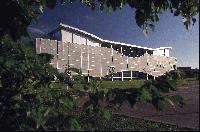|
Home : Innovation : Canadian Light Source
Canadian Light Source (CLS) Synchrotron
What is the Canadian Light Source?
Saskatoon is home to Canada's only synchrotron research facility and the biggest national scientific project in three decades. The stadium-sized synchrotron facility, located at the University of Saskatchewan, is lighting the way into a new era of science and innovation for academics and industry in Canada. The structure creates beams of light that are millions of times brighter than sunlight and act as a "super microscope." The light beams are guided into workstations where they are capable of isolating the microscopic nature of matter down to the level of an atom.
Officially opened in October 2004, the $174-million Canadian Light Source (CLS) synchrotron is only the second of a new class of synchrotron light sources in the world. It will enable Canada's synchrotron light users – in fields as diverse as biology, chemistry, geology, materials science, physics and medicine – to compete internationally. Using powerful magnets and radio frequency waves, the CLS synchrotron will accelerate electrons to nearly the speed of light, producing intense light beams for probing matter with unprecedented precision. It will create endless research opportunities across industrial, economic and social fields. With this high-tech tool, scientists will be able to design new drugs and medical treatments, improve food products, manufacture more powerful microchips and discover ways to clean up the environment.
What's the WD connection?
 Photo credit: Canadian Light Source Inc., University of Saskatchewan Western Economic Diversification Canada acted as a catalyst for the project, contributing over $25 million and helping bring together a consortium that includes the Saskatchewan, Ontario and Alberta governments, the City of Saskatoon, academia and industry.
Other federal partners include the Canada Foundation for Innovation, the National Research Council, Natural Resources Canada and NSERC, now also known as Science and Engineering Research Canada.
What's been accomplished?
An estimated 500 jobs were created through the four-year construction of the CLS. The CLS has focused the efforts of 27 universities from across the country, major industry partners and three levels of government. The facility is expected to have a total of 12 beamlines operating by 2008.
The national synchrotron facility welcomed its first researcher from an outside agency, Dr. Allen Pratt of Natural Resources Canada's CANMET Mining and Mineral Sciences Laboratories in Ottawa in May 2005. Dr. Pratt is using x-rays from one of the synchrotron's beamlines to study the minerals chalcopyrite and pyrite - commonly known as fool's gold. He is investigating how to more effectively separate these two minerals and real gold from raw ore during processing.
What's on the horizon?
Until now, Canada's synchrotron scientists have had to travel outside of the country to collect their data, lining up at overbooked synchrotrons in, for example, Europe and the United States.
When the facility becomes fully operational, more than 200 scientists, technicians and operational staff will work at the CLS and more than 2,000 academic and industrial researchers a year from across Canada and from other countries are expected to use the facility. An independent study has estimated that the CLS could attract $35 million annually in commercial research and development spending from universities and the private sector in Canada and abroad.
With its focus on public-private partnerships and its availability to industrial researchers, the CLS is unique in the world. Its target for industrial usage will be 25 per cent. Typically, synchrotrons primarily serve universities and government institutions with only about 10 per cent industrial usage.
The CLS promises major research breakthroughs in disciplines from the basic sciences of chemistry, physics, geology and biochemistry to the applied sciences of genomics, global warming, engineering, radiology and medicine, and will contribute to strengthening Canada's scientific leadership as well as making Canada one of the most innovative countries in the world.
Key Contact
Ed Wiens
Western Economic Diversification Canada
P.O. Box 2025
Suite 601, S.J. Cohen Building
119 4th Avenue South
Saskatoon, Saskatchewan
S7K 3S7
Phone: (306) 975-5854
1 888 338-WEST (9378)
Email: ed.wiens@wd.gc.ca
|
